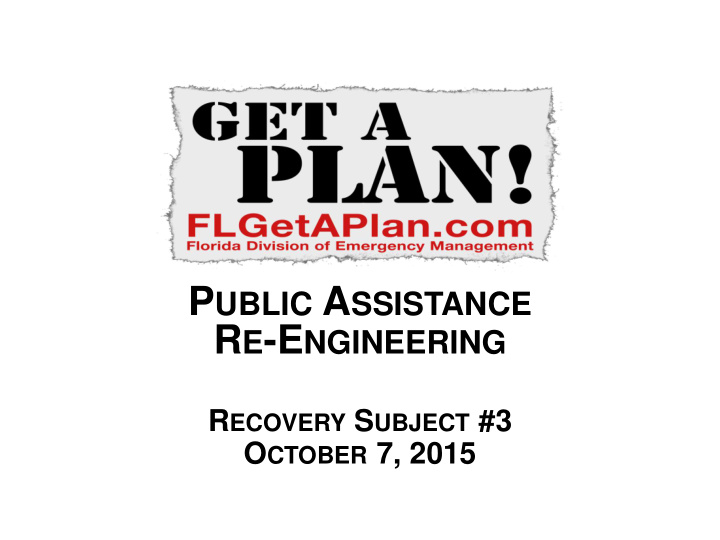



P UBLIC A SSISTANCE R E -E NGINEERING R ECOVERY S UBJECT #3 O CTOBER 7, 2015
I NTRODUCTION Problem: the current model for Public Assistance is broken… The current process allows for problems in the project formulation period to fester for years, resulting in multiple appeals The current process allows for continual review – paralysis by analysis The current process is “one-size fits all,” when we know that doesn’t work Solution: Re-Engineer the process! FEMA solicited stakeholder involvement from NEMA and State EMA’s Pilot test (partial implementation) currently underway – IA – DR-4234 Full up testing anticipated at a JFO later this Fall THE FLORIDA DIVISION OF EMERGENCY MANAGEMENT
P OLICY C HANGES Before we even get to Re-Engineering, FEMA commissioned a review of all policies that has taken place over the past year Some policy changes that are worth mentioning: SRIA Pilot Programs continue Supercircular consolidated grants guidance earlier this year Policy on Insurance was updated in July Policy on Section 705 issues released for public comment in late September FEMA will be re-issuing their procurement for PA TAC’s Unified guidance is being compiled, and will be available (hopefully) by January 2016 THE FLORIDA DIVISION OF EMERGENCY MANAGEMENT
T HE G OALS The goals behind all these policy changes feed the Re-Engineering process Goal 1 – Establish unified, non-contradictory guidance for Recipients and Subrecipients Goal 2 – Do more accurate work at the start of recovery, and eliminate the need for so many appeals later Goal 3 – Implement a process that can be easily tracked, and that does not have multiple queues that lead to delay Goal 4 – Reduce the timeframe in which it takes to close disasters THE FLORIDA DIVISION OF EMERGENCY MANAGEMENT
H IGHLIGHTS : P HASES & P ATHS Re-Engineering focuses on a realignment of PA into Phases and Paths: Phases – there will be 4 phases, each with distinct goals Paths – once projects are defined, there will be parallel paths through PA, depending on the complexity level of the project FEMA is stressing the role of guiding the Recipient and Subrecipient through this new system Each Subrecipient will be assigned a Program Delivery Coordinator (PDC), who will be the interface between the Recipient/Subrecipient and FEMA The PDC is not supposed to manage PAC’s, TAC’s & Project Specialists The PDC is supposed to manage the customer service to the subrecipients as the projects move through the PA paths THE FLORIDA DIVISION OF EMERGENCY MANAGEMENT
T HE O PERATIONAL P LANNING P HASE The first phase of the re-engineered PA process is the “Operational Planning Phase” The goals in this phase are: Establish Subrecipient eligibility Begin to scope the complexity of the Subrecipient’s projects, in order to properly assign the team of specialists who will write those projects THE FLORIDA DIVISION OF EMERGENCY MANAGEMENT
T HE O PERATIONAL P LANNING P HASE THE FLORIDA DIVISION OF EMERGENCY MANAGEMENT
T HE D AMAGE I NTAKE P HASE The second phase of the re-engineered PA process is the “Damage Intake Phase” The goals in this phase are: Identify “special considerations” issues, and address those issues prior to PW writing Identify the proper “path” for the particular PW Expedited Standard Specialized Determine the eligible damage and begin to develop the scope of work for the recovery project THE FLORIDA DIVISION OF EMERGENCY MANAGEMENT
P ARALLEL P ATHS With the advent of parallel paths in the Damage Intake Phase, we will no longer have one PAC/TAC develop all PW’s for a given Subrecipient Expedited Projects: Work is complete and documentation is complete – PAC/TAC writes project off of known scope of work Standard Projects: Work not yet complete – PAC/TAC writes project similarly to process used today Specialized Projects: Technical Specialists will analyze and develop scopes of work for these projects Likely to involve multiple Technical Specialists Likely to be handled by regional staff (to avoid constant changeovers) THE FLORIDA DIVISION OF EMERGENCY MANAGEMENT
T HE D AMAGE I NTAKE P HASE THE FLORIDA DIVISION OF EMERGENCY MANAGEMENT
T HE G RANT S COPING P HASE The third phase of the re-engineered PA process is the “Grant Scoping Phase” The goals in this phase are: Finalize scopes of work and cost estimates Validate scopes of work and cost estimates Ensure that special considerations have been addressed Write the PW and input into Grants Management System (EMMIE) THE FLORIDA DIVISION OF EMERGENCY MANAGEMENT
T HE G RANT S COPING P HASE THE FLORIDA DIVISION OF EMERGENCY MANAGEMENT
T HE R EVIEW & A PPROVAL P HASE The fourth phase of the re-engineered PA process is the “Review & Approval Phase” The goals in this phase are: Finalize application of insurance against final costs Approve 406 mitigation (when applicable) Final approval of PW by Subrecipient and Recipient Final approval of PW by FEMA (obligation!!!) THE FLORIDA DIVISION OF EMERGENCY MANAGEMENT
T HE R EVIEW & A PPROVAL P HASE THE FLORIDA DIVISION OF EMERGENCY MANAGEMENT
F INAL T HOUGHTS Notice that this process (theoretically) no longer results in: PW’s written by PAC’s/TAC’s who are beyond their level of expertise Eligibility questions that are left to closeout to resolve Appeals only as a result of closeout, which simply serve to extend the time to event closure Obviously the jury remains open as to whether this will succeed The one concern expressed to FEMA so far is that FEMA has to be ready to retrain and/or remove field staff who refuse to adapt to the new process THE FLORIDA DIVISION OF EMERGENCY MANAGEMENT
Q UESTIONS ? Evan Rosenberg Bureau Chief of Recovery evan.rosenberg@em.myflorida.com (850) 487-2293 THE FLORIDA DIVISION OF EMERGENCY MANAGEMENT
Recommend
More recommend